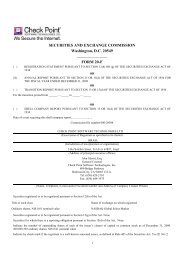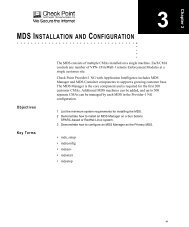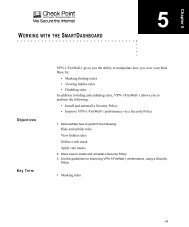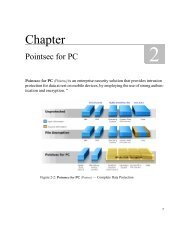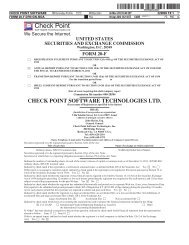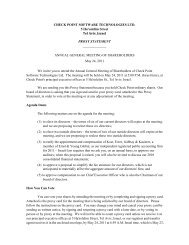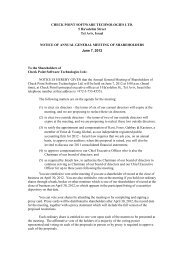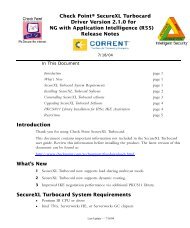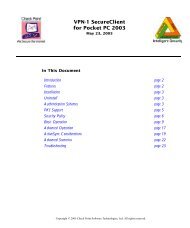You also want an ePaper? Increase the reach of your titles
YUMPU automatically turns print PDFs into web optimized ePapers that Google loves.
Capture a specific number of packets [-ci count] [-co count]<br />
<strong>fw</strong> moni<strong>to</strong>r enables you <strong>to</strong> limit the number of packets being captured. This is especially <strong>use</strong>ful in<br />
situations where the firewall is filtering high amounts of traffic. In such situations <strong>fw</strong> moni<strong>to</strong>r may bind<br />
so many resources (for writing <strong>to</strong> the console or <strong>to</strong> a file) that recognizing the break sequence (Control-C)<br />
might take very long.<br />
[Expert@cpmodule]# <strong>fw</strong> moni<strong>to</strong>r -ci 3 -o dump1.cap<br />
moni<strong>to</strong>r: getting filter (from command line)<br />
moni<strong>to</strong>r: compiling<br />
moni<strong>to</strong>rfilter:<br />
Compiled OK.<br />
moni<strong>to</strong>r: loading<br />
moni<strong>to</strong>r: moni<strong>to</strong>ring (control-C <strong>to</strong> s<strong>to</strong>p)<br />
12<br />
moni<strong>to</strong>r: unloading<br />
Read 3 inbound packets and 3 outbound packets<br />
[Expert@cpmodule]# <strong>fw</strong> moni<strong>to</strong>r -co 3 -o dump2.cap<br />
moni<strong>to</strong>r: getting filter (from command line)<br />
moni<strong>to</strong>r: compiling<br />
moni<strong>to</strong>rfilter:<br />
Compiled OK.<br />
moni<strong>to</strong>r: loading<br />
moni<strong>to</strong>r: moni<strong>to</strong>ring (control-C <strong>to</strong> s<strong>to</strong>p)<br />
14<br />
moni<strong>to</strong>r: unloading<br />
Read 4 inbound packets and 3 outbound packets<br />
Figure 6: <strong>fw</strong> moni<strong>to</strong>r – capture a specific number of packets<br />
<strong>fw</strong> moni<strong>to</strong>r counts "real" packets. In the example above we decided <strong>to</strong> capture just 3 packets. But the<br />
packet counter was 12 and 14. This can be explained by the multiple capture positions. In the first<br />
example we had three inbound and three outbound packets (six in sum). Each packet is counted <strong>to</strong> times<br />
(preInbound/postInbound or preOutbund/postOutbound):<br />
3 (inbound) * 2 (pre/post) + 3 (outbound) * 2 (pre/post) = 12 packets.<br />
The same for the second example:<br />
4 (inbound) * 2 (pre/post) + 3 (outbound) * 2 (pre/post) = 14 packets.<br />
! Please note that it is possible <strong>to</strong> <strong>use</strong> the –ci and the –co switches <strong>to</strong>gether. <strong>fw</strong> moni<strong>to</strong>r will s<strong>to</strong>p<br />
capturing packets if the number of packets for one of the two counters reaches it’s value.<br />
Capture on a specific Virtual Router or Virtual Machine [-vs vsid or vsname]<br />
FireWall-1 VSX enables you <strong>to</strong> run multiple Virtual Routers and FireWalls on one physical machine. Using<br />
the option –vs you can specify on which virtual component the packets should be captured. This option is<br />
only available on a FireWall-1 VSX module – not on a standard module. Please refer <strong>to</strong> <strong>fw</strong> moni<strong>to</strong>r on<br />
FireWall-1 VSX for more information.<br />
<strong>How</strong> <strong>to</strong> <strong>use</strong> <strong>fw</strong> moni<strong>to</strong>r Page 11 of 70<br />
Revision: 1.01



